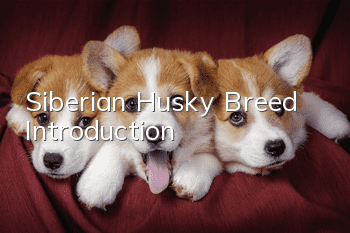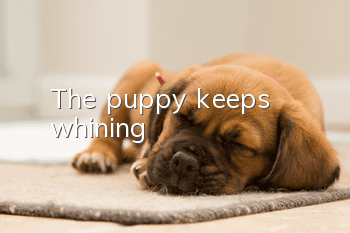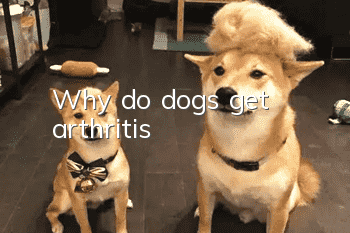Siberian Husky Breed Introduction

The editor of You Pet today introduces to you the Siberian Husky in the dog world. Some pet owners may still feel unfamiliar with it, but if the editor says its scientific name Erha or when it is released, will it suddenly dawn on it that it turns out to be He is such an internet celebrity.
The Siberian Husky weighs between 25 and 60 pounds (16 and 27 kg) and is about 20 and 23.5 inches (51 and 60 cm) tall. It is a medium-sized dog and an original ancient dog breed. It is found in northeastern Siberia and Greenland. Southern life.
The characteristic temperament of Siberian Huskies is friendly and gentle, but also alert, enthusiastic, smart, docile and enthusiastic. They can be raised in both urban and rural areas, preferably spacious. It's best to live in the suburbs, preferably with a fenced yard. It is also suitable for breeders who live in communities with lots of open space, are afraid of being alone and need someone to accompany them, and are energetic and exercise a lot. Not suitable for the elderly, office workers and students who don’t have much leisure time.
English name
SiberianHusky
History
The Siberian Husky is a dog breed bred by the Inutchok tribe, a nomadic tribe in East Siberia. It has always been responsible for pulling sleds, guiding reindeer and guarding. Moreover, it can work in the harsh environment of Siberia. Siberian Huskies have been living alone in Siberia for centuries. In the early 20th century, it was brought to the United States by fur traders. In a blink of an eye, this dog became the world-famous champion dog in sled racing. Today, this dog is loved by people as an excellent companion dog.
Character
The typical personality of the Husky is friendly, gentle, alert and likes to socialize. It will not show the strong territorial possessiveness of a guard dog, will not be too suspicious of strangers, and will not attack other dogs. Adult dogs should possess a certain level of caution and dignity. This breed is intelligent, docile, and enthusiastic, making a suitable companion and loyal worker.
Suitable people
It can be used in both urban and rural areas, preferably spacious. It is best to live in the suburbs, and it is better to have a fenced yard. It is also suitable for breeders who live in a community with more open space, are afraid of being alone and need someone to accompany them, and are energetic and exercise a lot. Not suitable for the elderly, office workers and students who don’t have much leisure time.
Dog Breed Standard
Appearance
The Siberian Husky is a medium-sized working dog with brisk steps and graceful movements. The body is compact, has a thick coat, erect ears, and a brush-like tail, showing the genetic characteristics of the northern region. The gait is characteristic: smooth and effortless. His earliest role was to pull a cart, and he is still very good at this job, and can travel considerable distances at moderate speeds while towing a light load. His body proportions and shape reflect strength, speed andThe most basic balance of endurance. The male is muscular, but not rough in outline; the female is full of feminine beauty, but not weak. Under normal conditions, a Siberian Husky with strong, well-developed muscles cannot tow heavy objects.
Size, proportion, appearance
Height: Males, 21-23 inches at withers; females, 20-22 inches.
Weight: Male, 45-60 pounds; female, 35-50 pounds. Weight should be coordinated with height. The above information represents the extreme values of height and weight. Anything outside of these limits cannot be considered excellent. A frame that is too big or too heavy will affect your performance. Viewed from the side, the length from the point of the withers to the lowest point of the croup is slightly greater than the height from the ground to the top of the withers.
Unqualified: Males over 23 inches, females over 22 inches.
Head
The expression is firm, but friendly; curious, even mischievous.
The eyes are almond-shaped, moderately spaced and slightly slanted. Eyes can be brown or blue; different eye colors are acceptable if they meet the color criteria.
Faults: Eyes too slanted; too close together. Ears of medium size, triangular, set close together and set high on the head.
The ears are thick and covered with thick hair. The neck is slightly arched where it connects to the head and is erect. The tip is slightly rounded and points straight upward.
Faults: The ears and head are out of proportion, appearing too large; too far apart; not erect enough.
The skull is of medium size and in good proportion to the body; slightly rounded at the top and tapering from the widest point to the eyes.
Faults: Clumsy or heavy head; too sharply defined head.
Stop (concave point on the face)-the stop is very obvious, and the bridge of the nose from the stop to the end is straight.
Defect: The stop is not obvious. The muzzle is of medium length, the length from the end of the nose to the stop being equal to the length from the stop to the occipital bone.
The muzzle is of medium width, tapering gradually, and is neither pointed nor square at the end.
Faults: Muzzle too thin or too thick; too short or too long. Nose: The nose of gray, tan or black dogs is black; the nose of bronze dogs is liver color; pure white dogs may have brightly colored noses. A pink striped "snow nose" is also acceptable.
Lips are evenly pigmented and tightly closed. Teeth scissor bite.
Faults: Non-scissor bite.
Neck, topline, body
Neck: Moderate in length, arched, and carried erect when the dog stands. When trotting, the neck is extended and the head is slightly forward.
Faults: neck too short,Too thick; too long.
Chest: Deep, strong, but not too broad, with the deepest point just behind and level with the elbows. The ribs are well spread outward from the spine but are flattened laterally to allow for free movement.
Faults: Chest too broad; "barrel ribs"; ribs too flat or weak.
Back: The back is straight and strong, with a straight topline from withers to croup. Medium length, not rounded or flabby due to excessive body length. The waist is tight, sloping, narrower than the ribcage, and slightly tucked in. The hips slide down from the spine at a certain angle, but the angle should not be too steep, so as not to affect the kicking force of the hind legs.
Faults: Loose, weak back; arched back; sloping topline.
Tail
The tail is very hairy, like a fox's tail, located just below the topline. When the dog stands at attention, the tail is usually carried on the back in a graceful sickle-shaped curve. The tail is carried neither curled to either side of the body nor flat on the back. Normally, dogs will wag their tails in response. The fur on the tail is of medium length, and the length of the fur on the top, sides and bottom is basically the same, so it looks like a round fox tail.
Faults: Tail laid flat or tightly rolled; tail set too high or too low.
Forequarters
Shoulders: The scapulae are drawn back. From the shoulder point to the elbow, the upper arm has a slight backward angle and is not perpendicular to the ground. The muscles and ligaments between the shoulders and ribcage are well developed.
Faults: Straight shoulders; loose shoulders. Forelegs: Viewed from the front when standing, the legs are moderately spaced, parallel, straight, with elbows close to the body and neither turned in nor turned out. Viewed from the side, the bony joints have a certain tilt angle, making them strong and flexible. The bones are strong and strong, but not heavy.
The distance of the legs from the elbow to the ground is slightly longer than the length from the elbow to the top of the withers. The upper claws of the front legs can be removed. Tilting: Weak joints; bones too bulky; legs too wide or too narrow when viewed from the front; elbows turned out. Feet oval, not long. The paws are medium in size, close together, and have rich hair between the toes and pads. The pads are tight and thick. When the dog is standing naturally, the feet should not be turned outward or inward.
Faults: Splayed feet, or weak toes; too large and clumsy claws; too small and slender claws; toes turned in or out.
Hindquarters
Viewed from the back when standing, the distance between the two hind legs is moderate and the legs are parallel. The upper thighs are well-muscled and powerful, the knees are fully bent, the ankles are well-defined and low to the ground. If there are upper claws, they can be removed. Faults: Straight stifles, cow-hocks, too narrow or too wide behind.
Coat
The coat of the Siberian Husky is double-layered, medium-length, and looksThe coat is dense but not so long that it obscures the clear outline of the dog. The undercoat is soft, dense, and long enough to support the outer coat. The coarse outer coat of hair is straight, smooth and lying, not rough or erect. It should be noted that it is normal to have no undercoat during the moulting period. Beards and the hair between the toes and around the feet can be trimmed for a neater appearance. Trimming other areas of hair is not allowed and is severely punished. Faults: The coat is long, rough, matted and fluffy; the texture is too rough or too silky; the coat is trimmed in areas other than those permitted above.
Color
All colors from black to pure white are accepted. Some other color spots on the head are common, including many patterns not found in other breeds.
Gait
The standard gait of the Siberian Husky is smooth and comfortable, seemingly effortless. The pace should be quick and light. Don't pull too hard on the playing field. You should run at a moderate pace, showing good extension of the forelimbs and strong driving force of the hind limbs. Looking from front to back when traveling, the Siberian Husky does not move in one direction. As the speed increases, the legs gradually extend forward until all the toes fall on the longitudinal center axis of the body. When the footprints are concentrated on a line, the front legs and hind legs are stretched out straight forward, and the elbows and knees cannot turn outward or inward. Each hind leg follows the path of the front leg on the same side. When the dog walks, the topline remains tight and level. Faults: Short, jumping or undulating gait; clumsy or rolling gait; crossing or crabbing gait.
Temperament
The typical personality of the Siberian Husky is friendly, gentle, alert and likes to socialize. He will not display the strong territorial possessiveness of a guard dog, will not be overly suspicious of strangers, and will not attack other dogs. Adult dogs should possess a certain level of caution and dignity. This breed is intelligent, docile, and enthusiastic, making a suitable companion and loyal worker.
Genetic diseases
Genetic diseases: hip dysplasia, cataracts.
Common diseases: diarrhea, acute gastric dilatation-volvulus, peptic ulcer, contact dermatitis, acute wet dermatitis, acute intestinal catarrh, fungal skin disease, bronchopneumonia, canine infectious hepatitis, peptic ulcer, Nocardia disease , progressive retinal atrophy, eosinophilic enteritis, canine brucellosis.
The Siberian Husky is called Husky mainly because of its hoarse bark, hence its name. Its fate seems to be destined. Even if it is not in the world, there are always many legends about it in the world. No matter what you think, the editor of Youpet gives them 32 likes from the bottom of my heart.
- How to treat canine infectious bronchitis? What medicine to take?
- Can parvovirus be transmitted to humans? Prevention and treatment of parvovirus!
- How to treat skin diseases in Teddy dogs?
- What are the causes of husky diarrhea? Causes and treatments of husky diarrhea!
- Teach you how to help your dog survive the hot summer and common sense about pet care!
- What should you pay attention to when neutering your dog? 7 must-see precautions for dog neutering surgery!
- Is it too late to vaccinate a dog until four months old?
- Do those dogs who died at the age of 12 really die?
- What should I do if my dog secretly takes too much cold medicine?
- What should I do if my one-month-old puppy keeps barking at night?



